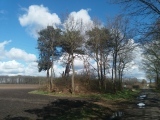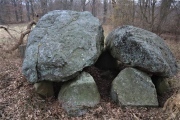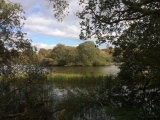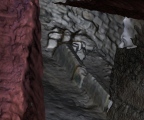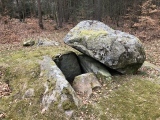Andy Burnham's Blog, page 174
April 17, 2021
Grabhügel bei Eitzte (5)
There are several well-preserved tumuli near the village of Eitzte in Lower Saxony, Bremen. See the other pages nearby for more. This is the fifth tumulus and it is right at the roadside. There is an information board and a small bench for hikers and cyclists. Extensive excavations have been carried out and a number of finds are being secured for research. The alternate name 'Hügelgräberfriedhof Eitzte' is the most official one for the whole area.
Published on April 17, 2021 07:41
April 14, 2021
Fiskebæk Skov Runddysse 1
Megalitgrav (Burial Chamber) in Maribo, Denmark. There are at least 30 cup marks on the eastern capstone (see photo lower down this page) and a few on the other stones also according to the Fortidsminder site database. The capstone is split and set side by side. No visible kerbstones.
Published on April 14, 2021 10:29
April 13, 2021
St Nem's Churchyard (Kilnave)
St Nem's kirkyard, Isle of Islay is in a remote village at the north-west tip of the island overlooking Loch Gruinart. An 8th century high-cross, now rather worn and damaged, can be found at the western side of the ruined church of St Nem (Naomh), who was a 6th century Irish saint.
Published on April 13, 2021 11:39
April 10, 2021
Carrock Fell
The geology of Carrock Fell is unique in Cumbria because of its Gabbro rock, the same as that of the Black Cuillin on the Isle of Skye. The fell is crowned by a large univallate hillfort, two round cairns and a medieval shieling located on the east-west summit ridge of Carrock Fell. The summit cairn pictured is modern. The enclosure measures approximately 245m east-west by 112m north-south and is surrounded by a drystone rampart up to 3m high and 4m wide which has tumbled and spread to a maximum of 17m wide in places. The highest part of the enclosure is a rocky knoll lying at the western end.
Published on April 10, 2021 07:07
April 9, 2021
Whitefield Loch Crannog
Off a minor road off the A747 going to Knock Fell this crannog can be viewed from the Forestry Commission Track at the east end of the loch, or from fishernmen's path from the west. The reedy area to the south of the crannog is presumably the remains of the original causeway.
Published on April 09, 2021 06:29
The Cairns Windwick Bay
The Life and Times of The Cairns, South Ronaldsay, free online talk on Wednesday, April 28th. Details in the comments on our page and for other updates from the dig. The Cairns overlooking Windiwick Bay on South Ronaldsay, Orkney have proved more of a puzzle than usual for the hardy archaeologists, in fact, it's a massive jigsaw puzzle. Excavation has shown the sites is a broch but with lots still to discover.
Published on April 09, 2021 05:14
April 8, 2021
Nestors Palace Tholos Tomb
From Archive to GIS: Recovering spatial information from the records of the 1953 excavation of Tholos IV at the Palace of Nestor. A beehive tomb, also known as a tholos tomb is a burial structure characterized by its false dome created by the superposition of successively smaller rings of mud bricks or stones. Excavation of this tomb began on 25 May 1953, directed by Lord William Taylour and undertaken by four workmen.
Published on April 08, 2021 06:13
Bryn y Castell
There is evidence of Iron smelting dating here from approximately 100BC to AD70 and again from AD150 to 250. Bog iron was smelted at Bryn y Castell hillfort and within an associated hut circle directly below the site. A well preserved section of Sarn Helen Roman military road passes through the high ground between Cwm Teigl and Cwm Gamallt, Gwynedd. (see the nearby sites list on our page for more). The Iron Age sites lying close to the road suggest a much older trackway existed before the Romans improved it.
Published on April 08, 2021 02:31
April 7, 2021
Horserød Hegn Langdysse 2
Langdysse (Long Barrow) in Frederiksborg. The photo shows the southern chamber with its huge capstone.
Published on April 07, 2021 11:55
April 5, 2021
Hajany Stone Row
An impressive stone row consisting of eight menhirs can be found by the country road on a small hill north of the Hajany village. The row was built up around 2008 by a company of stone enthusiasts called "Menhirostav". This fine group is mainly active in the Southern Bohemia region.
Published on April 05, 2021 13:09

